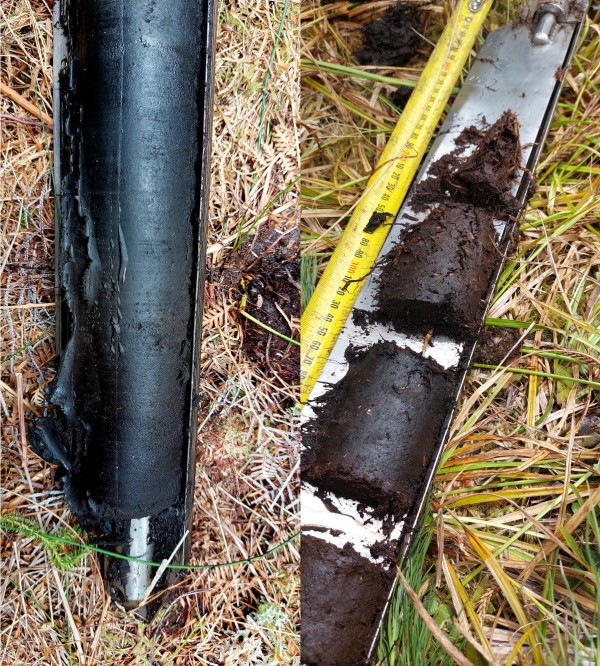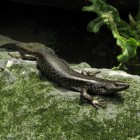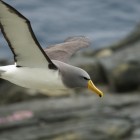Species and environment
Chatham Islands Wetlands
A huge proportion of the Chatham Islands are wetland ecosystems. Research about how to best protect Chatham Islands wetlands and measure the benefits is underway. This includes research about storing carbon in peatlands.
Wetland ecosystems on the Chathams
These important ecosystems provide invaluable services for life.
Wetlands act like a filtration system and improve water quality, store floodwaters, and help maintain water flow during dry periods. They’re a prime spot for biodiversity; birds, fish, plants, invertebrates, and other species depend on wetlands. About two thirds of Chatham endemic flowering plants grow in these areas, including Chatham Island swamp aster (Macrolearia semidentata), a gentian (Gentianella chathamica), Cox’s matipo (Myrsine coxii), and the Chatham Island bamboo rush (Sporadanthus traversii). Many of our tree species have a swamp variant, adapted to living in a wet environment.
Our wetlands are also a source of recreation and food for islanders. Whitebaiting season, shellfish hunting, swan egg gathering, and Christmas camping around Te Whanga all centre around healthy freshwater and wetlands. Delicious tarahinau honey also comes courtesy of wetlands. Tarahinau is a dracophyllum and grows inland and in peaty soils.
Wetlands also have huge potential to help us respond to climate change. This is especially important for a remote island in the Pacific.
River mouth at Waitangi, Chatham Islands. Image: Milly Farquar
Types of wetland

Chatham Island swamp aster. Image: DOC Eric Edwards
On the Chatham Islands there are a range of wetland types, including bogs, swamps, fens, seepages, marshes, dune lakes, peat lakes, ponds, and streams.
The underlying geology of the islands dictates this. For example, sand dunes have given rise to dune lakes. Areas of thick clay over basalt and schist impede drainage which, coupled with the islands’ foggy and rainy weather, has resulted in the formation of peat. One of the gems is the restiad peat bog, a kind of wetland found in only a few parts of the world.
Peatlands are the most common Chatham wetland. Around 60% of Chatham soil is peat, and it can be as deep as 10m. The Chathams have around 42,000ha of peatland. Compared to the mainland, these areas are relatively unmodified, which means restoration and protection will take less work to get them to a healthy state.
Like all wetlands, peatlands provide a huge range of ecosystem services. Formed over millions of years from decaying plant matter, Chatham peat is ancient and holds a detailed history of the past climate and flora, as well as storing records of historic fires and even volcanic eruptions from the North Island. Peatlands are also incredible carbon sinks.
Peat Carbon research
A research project exploring the potential Chatham Island peatlands have for storing carbon has provided initial quantifiable data about their climate benefits, and could open a potential alternative income source for landowners.
The project has taken core samples from seven wetlands around main Chatham. Each sample is 50 cm long, taken from the upper portion of the peat. Samples are taken from areas that are currently being grazed or have been drained, and areas that have been fenced off to exclude livestock. Back in the lab, these samples have been analysed to reveal their composition and chemistry.
This research was funded through an Essential Freshwater project by Agri Concepts. Radboud University (Netherlands) Masters student Rabia Sheikh has also had support from the Chatham Islands Landscape Restoration Trust and The Nature Conservancy.

Two core samples from Chatham peatlands. Image: Peter de Lange
Carbon storage in peatlands
Peatlands occur everywhere on the planet. Globally, they store about twice as much carbon as the world’s forests. Unfortunately, when they’re drained, burned, or subjected to prolonged grazing and pugging from livestock, peatlands go from storing carbon in their soil layers to releasing that carbon dioxide into the atmosphere.
Restoring degraded wetlands and protecting healthy ones increases their capacity to remove carbon from our atmosphere and to store it.
Possible alternative land use for peatlands
The research team are seeking funding for further research into the function of these peatland ecosystems, which will allow them to explore opportunities for carbon credits on the open carbon market.
In some places overseas like the United Kingdom, peatlands are already contributing to the open carbon market with voluntary initiatives like the Peatland Code. A similar set up in New Zealand would allow landowners to earn a passive income on land that is already marginal for farming.
Swamp tarahinau. Image: Tom Hitchon
Natural resource mapping
Another research project is mapping Chathams ecosystems, currently focusing on Te Whanga lagoon on Rēkohu / Wharekauri / Chatham Island. This is a kind of stock take of our islands’ natural resources. Similar work has happened in other areas of Aotearoa, but has been limited on the Chathams so far.
The aim to is help identify priority natural areas that the island can focus on as a community, and develop a plan for what can be protected and how it might be done. This work will also provide helpful guidance for people interested in restoration – especially landowners interested in sustainable use of their land.
Want help mapping your land or farm?
A free service is currently available to help Chatham landowners create a farm or property map.
This can help with managing your land more effectively, and identify practical alternative land use options. It includes help with choosing where to set paddock boundaries, mapping wetlands, and areas for potential restoration work.
Get in touch with Ruby Mulinder from Agri Concepts to find out more. Email ruby@agriconcepts.nz


